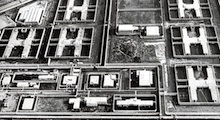
Agreement has been reached on the development of the site of the former Long Kesh prison as a peace-building and conflict resolution facility.
The deal was announced by Sinn Fein’s Deputy First Minister, Martin McGuinness, during the opening of a motorway section on the Dublin-Belfast route. Details were released later by the Office of the First Minister and Deputy First Minister.
The listed and retained buildings include one of the H-blocks, the prison hospital, as well as the visitors and administration blocks, which will all be open to the public.
It was announced that a motion on the plan is to be tabled in the Stormont Assembly. If approved, a development corporation will be set up to oversee the opening and redevelopment of the site including the construction of a “peace-building and conflict resolution facility”.
Mr McGuinness said the First Minister’s office would shortly submit an application for European funding for what he anticipated would be “a world-class facility of international importance”.
Peace funds from Europe are critical to the plan to develop the facility, located 14km from Belfast on the outskirts of Lisburn.
Mr Robinson claimed the project could create some 6,000 jobs, “securing the construction industry in Northern Ireland for years to come.
“This announcement represents agreement on another one of the outstanding issues facing the Executive.”
The surprise announcement revived long-standing unionist fears that the site could become a “shrine” to IRA and INLA hunger strikers, ten of whom died in the 1981 protest.
Some unionists have opposed any development at the site which might show the hunger strikers in a positive light.
Ulster Unionist leader Reg Empey said that he was worried by the development.
“The prison is regarded very differently by different political traditions it would be a shame for the facility itself to become a symbol or division,” he said.
Sinn Fein’s Barry McElduff said there would be opportunities for the stories of the prisoners to be told.
“As republicans we obviously think of the many people who have went through the jail throughout its history and of course prisoners struggle for political status,” he said.
“Others including those who worked there also have their story to tell.
“We believe that there are many benefits for the wider community to engage with the history of the jail.
“We now need to see work progress and the site developed and open to the public.”
However the DUP’s Jeffrey Donaldson claimed his party had ensured there would be “no question of any shrine at the site”.
“There will be proper oversight and scrutiny to ensure that any facility there is in line with the requirements for a shared future and not symbolical of our divided past,” he said.
Originally a base for Britain’s Royal Air Force, the site was used to house political prisoners from 1971 to 2000, firstly as the Long Kesh Detention Centre and from 1976 in H-shaped buildings under the name of HMP Maze.
When the prison closed in September 2000, the British government presented the site to the Six-County Executive.
![[Irish Republican News]](https://republican-news.org/graphics/title_gifs/rn.gif)
![[Irish Republican News]](https://republican-news.org/graphics/title_gifs/harp.gif)

